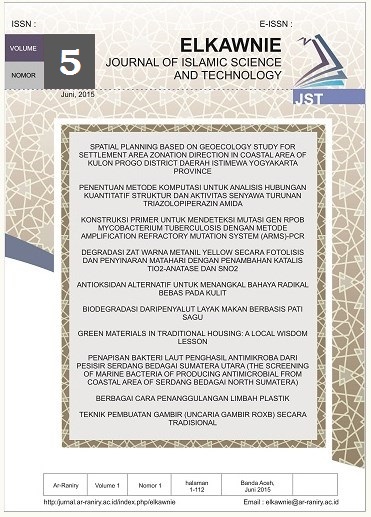Analytical Study of Circulation and Space Arrangement of Baiturrahman Grand Mosque Based on Gender According to Islamic Sharia Analysis
DOI:
https://doi.org/10.22373/ekw.v5i2.5287Keywords:
space circulation, gender space, mosque architectureAbstract
The mosque is a Muslim worship building that is commonly found in Muslim-populated areas. As the main building in Islam, with its significant role, it is relevant if the mosque building applies Islamic concepts in its spatial arrangement and circulation. One of them is the concept of gender-based spatial arrangement. However, in the mosque's spatial arrangement and circulation, it is often found that the arrangement is not in accordance with the Islamic principles. This causes discomfort for some building users. This study revealed an analysis of circulation and spatial arrangement in the Baiturrahman Grand Mosque building, the largest mosque in Banda Aceh, which became an icon of the city of Banda Aceh. This study is also carried out based on gender in accordance with Islamic sharia. Using the qualitative approach, observation being carried out as well as the study of Islamic source and Ching’s theory of circulation. The result shows that there is still a potential of ikhtilath (mingled each other between genders) happened in the recent space arrangement and circulation of the Baiturrahman Grand Mosque.
References
Bouwsema-Raap, Wilhelmina (2009). The Great Mosque of Banda Aceh: Its History, Architecture and Relationship to The Development of Islam in Sumatra. White Lotus Press.
Ching, Francis D. K. (1993). Architecture Form, Space, and Order. John Wiley&Sons, Inc. New Jersey.
Laksono, Pebri Arif (2015). Konsep Tata Ruang Masjid Nabawi Pada Masa Nabi Muhammad Saw. Universitas Gadjah Mada, Yogyakarta.
Mustafa, F. & Hassan, A. (2013). Mosque layout design: An analytical study of mosque layouts in the early Ottoman period. Frontiers of Architectural Research. 2. 10.1016/j.foar.2013.08.005.
Pynkyawati, T., Wahadamaputera, S., Adiwibowo, F., Lestari, R.R., Septaningsih, D.P. (2009). Kajian Desain Sirkulasi Ruang Dalam sebagai Sarana Evakuasi Kebakaran pada Bangunan Hotel Carrcadin Bandung. Jurnal Itenas Rekayasa. No.4. Vol. XIII.
Pynkyawati, T., Alpi G, M., Hendarsyah, R., Amhar, F. (2012). Kajian Desain Sirkulasi Ruang Luar dan Ruang Dalam bagi Penyandang Cacat pada Kawasan Bangunan Ciwalk (Cihampelas Walk). Jurnal Arsitektur Universitas Bandar Lampung.
Pynkyawati, T., Hamzah, R., Nugraha, S.S., Ramdhani, R.W. (2013). Kajian Desain Pola Sirkulasi sebagai Sarana Evakuasi Kebakaran pada Bangunan IGD dan COT di RSHS Bandung. Jurnal Reka Karsa, No.3, Vol.1.
Pynkyawati, T., Aripin, S., Ilyasa, E., Ningsih, L.Y., Amri, A. (2014). Kajian Efisiensi Desain Sirkulasi pada Fungsi Bangunan Mall Dan Hotel BTC. Jurnal Reka Karsa. No. 1, Vol. 4.
Downloads
Additional Files
Published
Issue
Section
License
Proposed Policy for Journals That Offer Open Access Authors who publish with the Elkawnie journal agree to the following terms:
a. Authors retain copyright and grant the journal right of first publication with the work simultaneously licensed under a Creative Commons Attribution License that allows others to share the work with an acknowledgement of the work's authorship and initial publication in this journal.
b. Authors are able to enter into separate, additional contractual arrangements for the non-exclusive distribution of the journal's published version of the work (e.g., post it to an institutional repository or publish it in a book), with an acknowledgement of its initial publication in this journal.
c. Authors are permitted and encouraged to post their work online (e.g., in institutional repositories or on their website) prior to and during the submission process, as it can lead to productive exchanges, as well as earlier and greater citation of published work (see The Effect of Open Access).

























